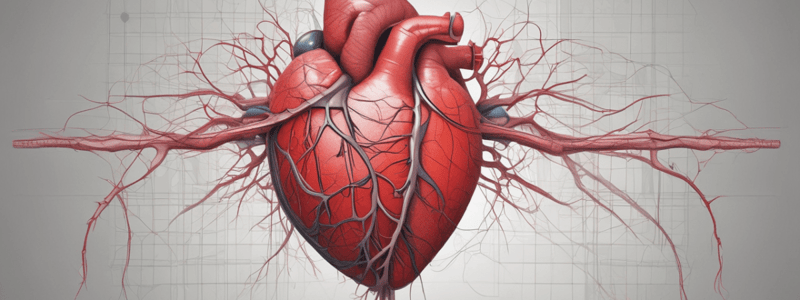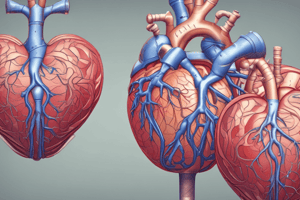Podcast
Questions and Answers
What is the primary function of the pericardium?
What is the primary function of the pericardium?
- To regulate blood pressure
- To filter deoxygenated blood from the myocardium
- To increase blood flow to the myocardium
- To limit the heart's motion and prevent overfilling (correct)
Which artery supplies the left atrium and left ventricle?
Which artery supplies the left atrium and left ventricle?
- Left circumflex artery (LCX)
- Posterior descending artery (PDA)
- Right coronary artery (RCA)
- Left coronary artery (LCA) (correct)
What is the term for the artery that gives rise to the posterior descending artery (PDA)?
What is the term for the artery that gives rise to the posterior descending artery (PDA)?
- Vascular dominance
- Arterial dominance
- Cardiac dominance
- Coronary dominance (correct)
What is the purpose of the cardiac veins?
What is the purpose of the cardiac veins?
What is the consequence of fluid accumulation in the pericardial sac?
What is the consequence of fluid accumulation in the pericardial sac?
Which artery branches into the left anterior descending artery (LAD) and the left circumflex artery (LCX)?
Which artery branches into the left anterior descending artery (LAD) and the left circumflex artery (LCX)?
What is the relationship between the phrenic nerves and the pericardium?
What is the relationship between the phrenic nerves and the pericardium?
What is the term for the artery that supplies the right atrium and ventricle?
What is the term for the artery that supplies the right atrium and ventricle?
What is the function of the pericardium?
What is the function of the pericardium?
What separates the atria from the ventricles?
What separates the atria from the ventricles?
Which of the following vessels carries oxygenated blood from the lungs to the heart?
Which of the following vessels carries oxygenated blood from the lungs to the heart?
Where is the heart located?
Where is the heart located?
What is the path of blood flow from the right atrium to the lungs?
What is the path of blood flow from the right atrium to the lungs?
What are the two main vessels that divide the right and left ventricles?
What are the two main vessels that divide the right and left ventricles?
What is the name of the valve that separates the right atrium and right ventricle?
What is the name of the valve that separates the right atrium and right ventricle?
Which of the following vessels is NOT a part of the coronary circulation?
Which of the following vessels is NOT a part of the coronary circulation?
What is the primary function of the pericardium in relation to the heart's movement?
What is the primary function of the pericardium in relation to the heart's movement?
Which of the following structures is responsible for pumping oxygenated blood to the rest of the body?
Which of the following structures is responsible for pumping oxygenated blood to the rest of the body?
What is the function of the pericardial fluid?
What is the function of the pericardial fluid?
Which of the following nerves is closely related to the pericardium?
Which of the following nerves is closely related to the pericardium?
What is the consequence of excessive fluid accumulation in the pericardial sac?
What is the consequence of excessive fluid accumulation in the pericardial sac?
What is the primary function of the coronary circulation?
What is the primary function of the coronary circulation?
Which of the following coronary arteries supplies the right atrium and right ventricle?
Which of the following coronary arteries supplies the right atrium and right ventricle?
What is the consequence of inadequate blood supply to the heart muscle?
What is the consequence of inadequate blood supply to the heart muscle?
Flashcards are hidden until you start studying
Study Notes
Coronary Arteries
- The right coronary artery (RCA) supplies the right atrium and ventricle, SA nodal artery, and posterior descending artery (PDA).
- The left coronary artery (LCA) supplies the left atrium and ventricle, and branches into the left anterior descending artery (LAD) and left circumflex artery (LCX).
- Coronary dominance refers to the artery that supplies the PDA, which can be right, left, or co-dominant.
Structure and Function of the Pericardium
- The pericardium is a protective sac that surrounds and supports the heart, limiting its motion and preventing overfilling.
- The pericardial cavity contains a small amount of fluid for lubrication and protection from infection.
- The pericardium is closely related to the phrenic nerves, and problems with the pericardium can cause referred pain.
- Fluid accumulation in the pericardial sac can lead to cardiac tamponade, a serious condition requiring immediate attention.
Coronary Circulation
- The coronary circulation supplies the heart muscle (myocardium) with oxygen and nutrients.
- The right coronary artery (RCA) supplies the right atrium and ventricle, SA nodal artery, and PDA.
- The left coronary artery (LCA) supplies the left atrium and ventricle, LAD, and LCX.
- Oxygenated blood returns to the left atrium through the pulmonary veins.
- Blood passes from the left atrium to the left ventricle through the bicuspid (mitral) valve.
- The left ventricle pumps oxygenated blood to the rest of the body through the aorta.
Cardiac Veins
- Cardiac veins drain deoxygenated blood from the myocardium.
- The great cardiac vein, middle cardiac vein, and small cardiac vein are important cardiac veins.
- They collect blood and drain it into the coronary sinus, which then empties into the right atrium.
Studying That Suits You
Use AI to generate personalized quizzes and flashcards to suit your learning preferences.




